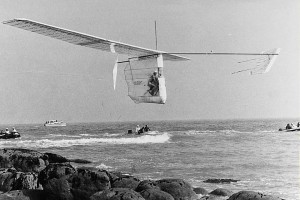I grew up with a blue Schwinn bike. It had a bell strapped to the handlebars, and a pedal guard to keep your pants from tangling in the chain. I rode that bike every day, uphill to school, and downhill home again.
In the afternoon I liked to veer hard onto the last steep downhill block and take it at top speed, then coast the rest of the way home on sheer momentum. The only problem was that the bottom of the hill was an uncontrolled intersection—no stop signs in any direction. I had to be alert as I furiously careened into that corner. If a car was coming to my right or left, I was ready to ditch the bike at the last instant, without a second thought.
I didn’t wish for a stop sign, so I could have the right of way through the bottom of the hill. Instead, I would have preferred to get up enough speed to actually lift off the roadway, to gain an altitude of twelve feet or so and soar over any car that might be approaching on the cross street.
The dream of a flying bicycle! Even at the very moment I was taunting death at the intersection of Dearborn and Center Street, a British company was working on it.
Dr. Paul B. MacCready led the AeroVironment team developing pedal-powered aircraft in the 1970s. The Gossamer Condor was the flying machine that won them a prize of 50,000 pounds in August 1977. Rider Bryan Allen propelled the Condor over a figure eight course at a minimum altitude of ten feet, around two markers a half-mile apart. It didn’t have wheels, so it wasn’t exactly a flying bicycle, but the Gossamer Condor did fly under the power of a rider cranking foot-pedals to turn a propeller.
In June 1979 Allen piloted a more advanced human-powered aircraft called the Gossamer Albatross across the English Channel. The distance was more than 22 miles. The Albatross weighed about 70 pounds and had a wingspan of almost 100 feet. The pilot sat on a bicycle seat, wearing a helmet, inside a transparent plastic bubble that hung below the wings.

During the Channel crossing, boats were following the aircraft, and pilot Allen radioed down that he had reached his limit. The exertion of pedaling that huge two-bladed propeller was grueling, and he couldn’t go any further. Allen was given permission to crash-land the Albatross in the choppy sea. He stopped pedaling, and the plane began to lose altitude. Unexpectedly, Allen found that as he descended, the air currents closer to the water’s surface made for easier flying. He began turning the pedals again, and the Gossamer Albatross completed the Channel crossing on its first attempt.
I used to talk about flying bicycles often, to anybody who would listen, like my co-worker James Carpenter at WC’s Pizzeria. He took the disposable white paper kitchen hat off my head and drew a picture on it, depicting me on a bike with wings. He labeled this cartoon “Father of Flight.”
I wrote a song lyric, too. It included these lines:
I’m earthbound and landlocked when just standing still
I can only take off by careening downhill.
I’m pushing the pedals, they’re turning the prop
And I’ll fall to the street if I ever once stop.
Want to hear this song? Yes, this obsession of mine made it onto CD in 2006. My friend and collaborator C.P Butchvarov set it to music and recorded it on his album Crazy Fretboard Symphony. Click the link for track 6, “Bicycle.”
I‘m still eager to have a flying bicycle, suitable for pedal-powered commuter aviation. It would have a cruising altitude of, say, 55 feet, and an average speed of maybe 15 miles per hour. You’d follow the urban roadways, the same as all the motorized vehicles. But they’d be below you. And you’d fold up the wings and park it with a chain lock at a bike rack.
In the meantime, a hand-made pedal-powered plane fills an important role in the manuscript for my novel, Silver Sparks. I still haven’t gotten over that obsession that took hold of me on the way home from school in the seventh grade.
Silver winged bicycle rides on the sky
And you were so sure that it never would fly!